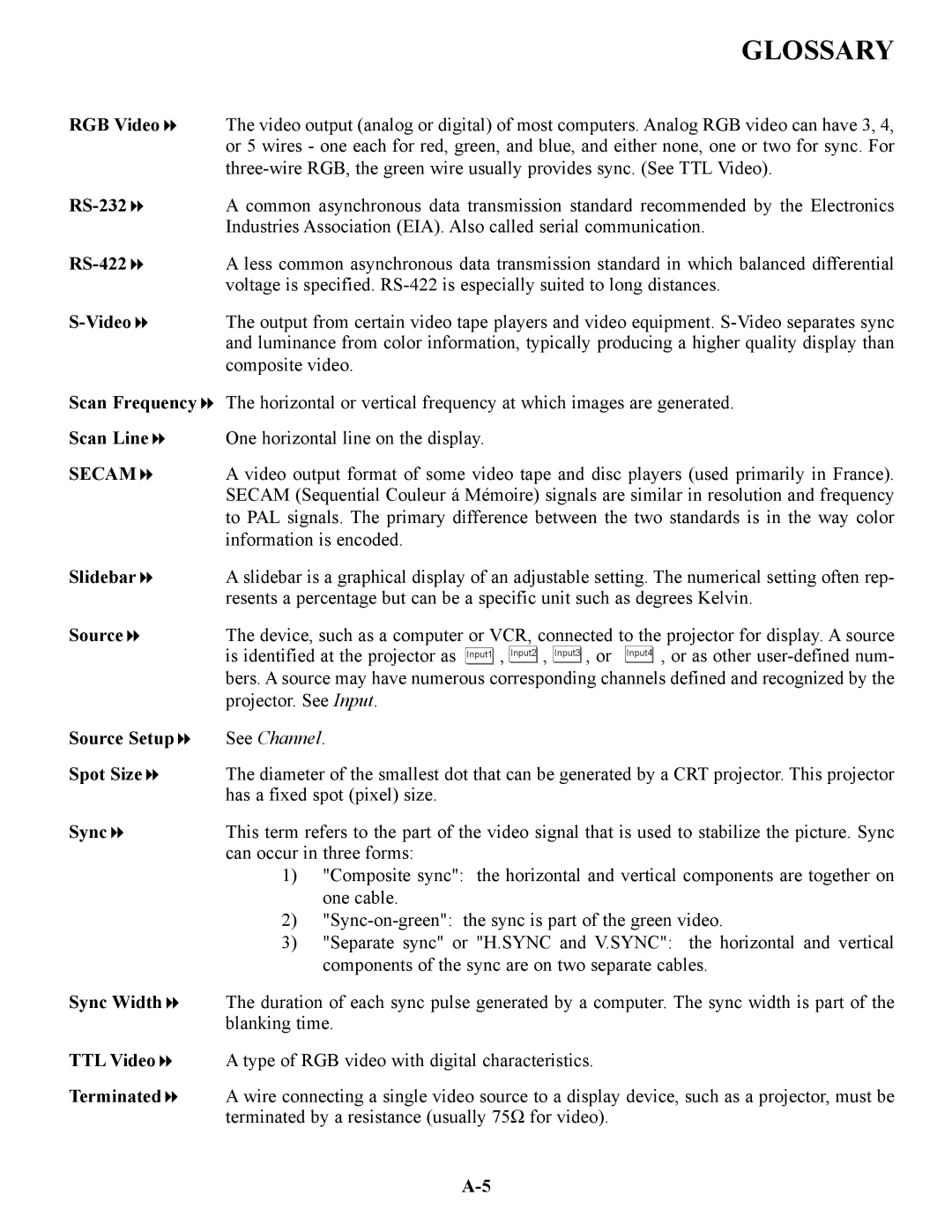|
|
|
|
|
|
|
|
| GLOSSARY |
RGB Video | The video output (analog or digital) of most computers. Analog RGB video can have 3, 4, | ||||||||
| or 5 wires - one each for red, green, and blue, and either none, one or two for sync. For | ||||||||
| |||||||||
| A common asynchronous data transmission standard recommended by the Electronics | ||||||||
| Industries Association (EIA). Also called serial communication. | ||||||||
| A less common asynchronous data transmission standard in which balanced differential | ||||||||
| voltage is specified. | ||||||||
| The output from certain video tape players and video equipment. | ||||||||
| and luminance from color information, typically producing a higher quality display than | ||||||||
| composite video. | ||||||||
Scan Frequency | The horizontal or vertical frequency at which images are generated. | ||||||||
Scan Line | One horizontal line on the display. | ||||||||
SECAM | A video output format of some video tape and disc players (used primarily in France). | ||||||||
| SECAM (Sequential Couleur á Mémoire) signals are similar in resolution and frequency | ||||||||
| to PAL signals. The primary difference between the two standards is in the way color | ||||||||
| information is encoded. | ||||||||
Slidebar | A slidebar is a graphical display of an adjustable setting. The numerical setting often rep- | ||||||||
| resents a percentage but can be a specific unit such as degrees Kelvin. | ||||||||
Source | The device, such as a computer or VCR, connected to the projector for display. A source | ||||||||
| is identified at the projector as |
| , | Input2 | , | Input3 | , or | Input4 | , or as other |
| Input1 | ||||||||
| |||||||||
| bers. A source may have numerous corresponding channels defined and recognized by the | ||||||||
| projector. See Input. | ||||||||
Source Setup | See Channel. | ||||||||
Spot Size | The diameter of the smallest dot that can be generated by a CRT projector. This projector | ||||||||
| has a fixed spot (pixel) size. | ||||||||
Sync | This term refers to the part of the video signal that is used to stabilize the picture. Sync | ||||||||
| can occur in three forms: | ||||||||
| 1) "Composite sync": the horizontal and vertical components are together on | ||||||||
| one cable. | ||||||||
| 2) | ||||||||
| 3) "Separate sync" or "H.SYNC and V.SYNC": the horizontal and vertical | ||||||||
| components of the sync are on two separate cables. | ||||||||
Sync Width | The duration of each sync pulse generated by a computer. The sync width is part of the | ||||||||
| blanking time. | ||||||||
TTL Video | A type of RGB video with digital characteristics. | ||||||||
Terminated | A wire connecting a single video source to a display device, such as a projector, must be | ||||||||
| terminated by a resistance (usually 75Ω for video). | ||||||||
